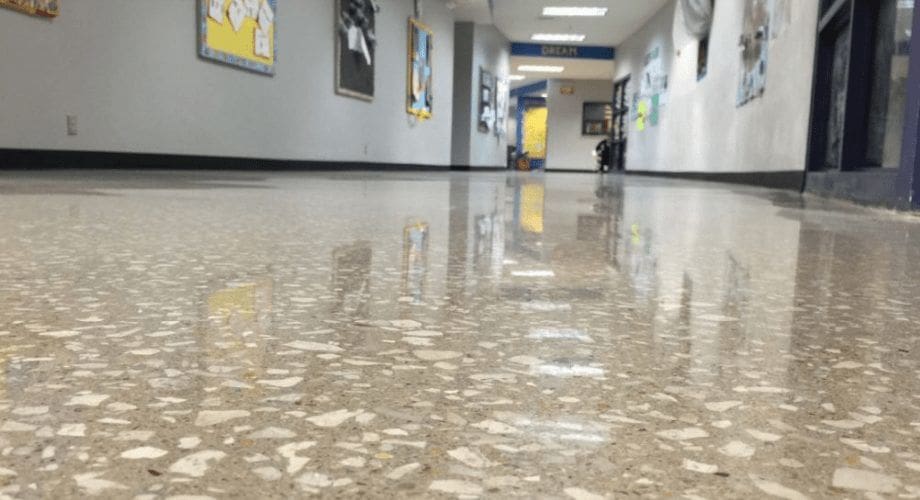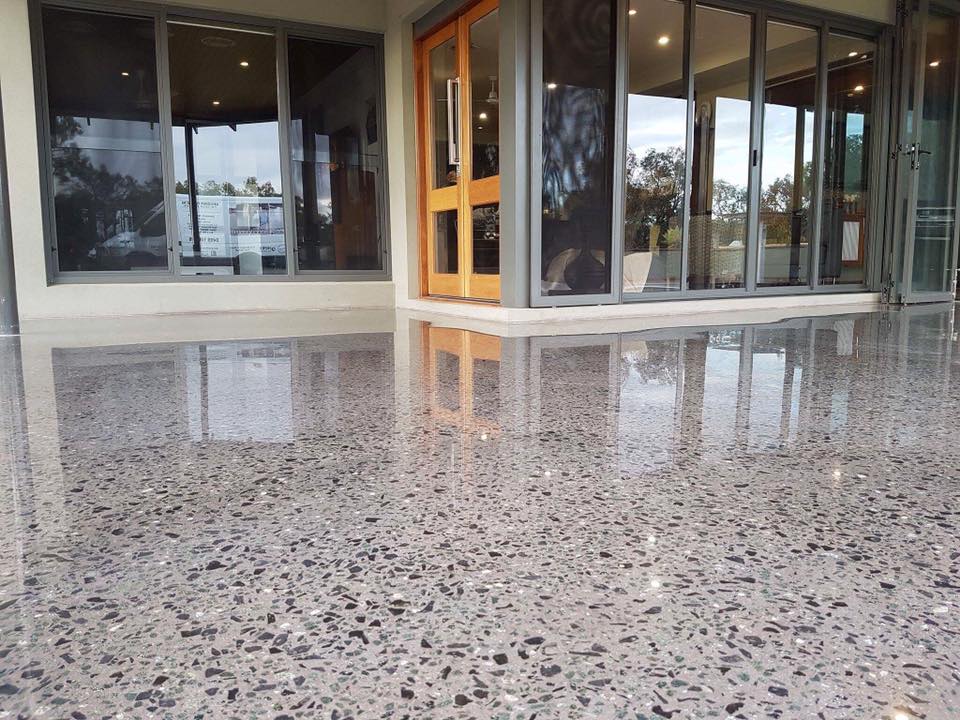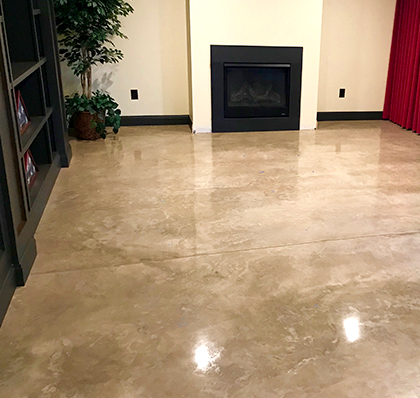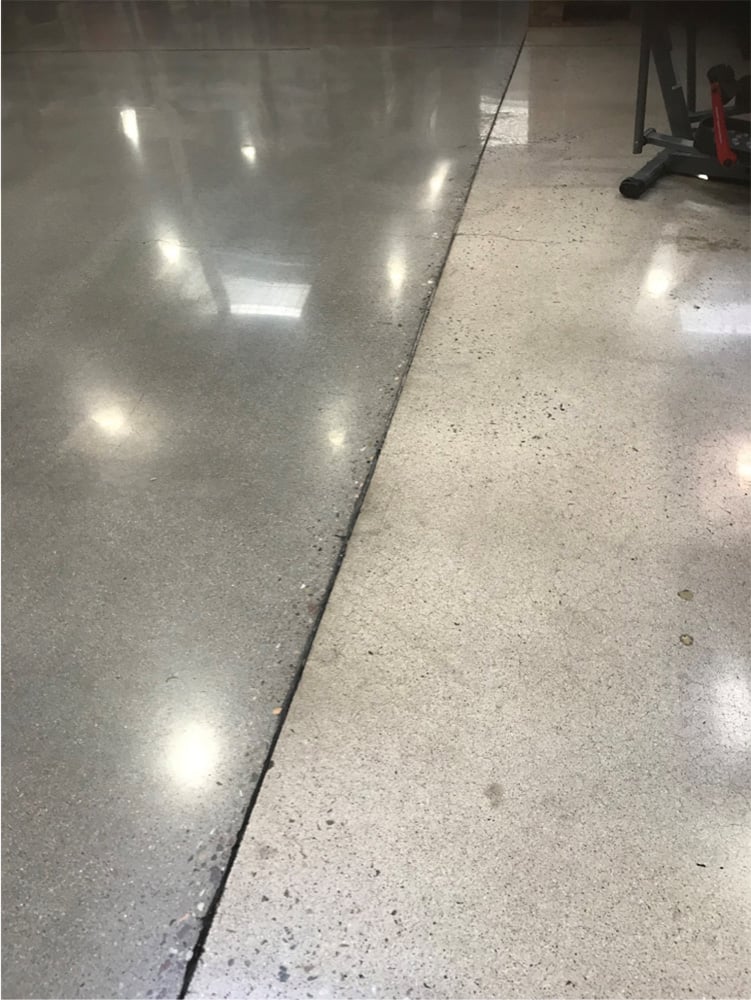Preparing the Concrete Surface
Before starting the process of polishing a concrete floor, it is crucial to prepare the surface properly. Adequate preparation ensures that the final result is smooth, even, and long-lasting. Here are the steps to follow in order to prepare the concrete surface for polishing:
- Clean the Surface: Begin by removing any loose debris, dirt, or dust from the concrete surface. Use a broom or vacuum cleaner to thoroughly clean the area. It is essential to eliminate all contaminants to ensure a successful polishing process.
- Repair Any Damage: Inspect the concrete surface for any cracks, holes, or other damage. Repair these imperfections using an appropriate concrete patching compound. Ensure that the patch is leveled and smooth before proceeding.
- Remove Existing Coatings: If there are any existing coatings or sealers on the concrete surface, they need to be removed. Use a chemical stripper or mechanical method such as grinding or shot blasting to eliminate these coatings. This step is essential to ensure proper adhesion of the polishing materials.
- Profile the Surface: Profiling the concrete surface involves creating a rough texture to enhance the bonding of the polishing materials. This can be achieved through mechanical methods like grinding or shot blasting. The level of profiling required depends on the desired finish and the condition of the concrete.
- Fill in Gaps and Joints: Check for any gaps or joints in the concrete surface and fill them with an appropriate filler. This step ensures a smooth and uniform appearance after the polishing process.
- Moisture Testing: Conduct a moisture test on the concrete surface to ensure it is dry enough for the polishing process. Excess moisture can interfere with the bonding of the polishing materials and lead to issues in the future. Various moisture testing methods are available, including the use of moisture meters or plastic sheet tests.
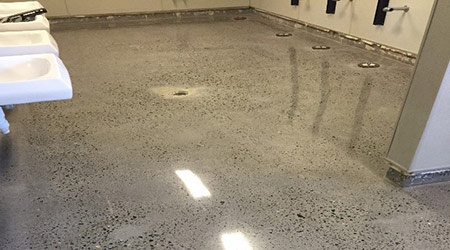
Choosing the Right Tools and Materials
When it comes to achieving a polished concrete floor, choosing the right tools and materials is essential. Here are some factors to consider when selecting the tools and materials for your project:
Grinding Machine: The first tool you will need is a grinding machine specifically designed for polishing concrete. There are various types available, including planetary grinders, rotary grinders, and hand-held grinders. The size and power of the machine will depend on the size of your project and the level of polish you want to achieve.
Diamond Grinding Pads: Diamond grinding pads are crucial for the grinding process. They come in various grits, ranging from coarse to fine. Coarser grits are used for initial grinding to remove any imperfections, while finer grits are used for achieving a smooth and glossy finish. Make sure to choose high-quality diamond pads that are compatible with your grinding machine.
Dust Collection System: Grinding concrete generates a significant amount of dust. To ensure a clean and safe working environment, it is important to invest in a dust collection system. This can be in the form of a vacuum attachment for your grinding machine or a separate dust extractor. A good dust collection system will effectively capture and contain the dust, preventing it from spreading throughout the space.
Hardener and Densifier: Applying a hardener and densifier to the concrete surface is essential for achieving a polished finish. These products penetrate the concrete, filling in the pores and strengthening the surface. They also help to reduce dusting and increase the durability of the floor. Choose a hardener and densifier that is suitable for your specific concrete type and follow the manufacturer’s instructions for application.
Polishing Pads: Once the grinding process is complete, it’s time to move on to polishing. Polishing pads come in various grits, similar to diamond grinding pads. Starting with a coarse pad and gradually moving to finer pads will help you achieve a high-gloss finish. The polishing pads can be used with a polishing machine or a burnishing machine, depending on the size and complexity of your project.
Sealer: To protect and enhance the appearance of your polished concrete floor, applying a sealer is recommended. There are different types of sealers available, including topical sealers and penetrating sealers. Consider factors such as the level of gloss you desire, the expected foot traffic, and the ease of maintenance when choosing a sealer.
Step-by-Step Guide to Polishing the Floor
- Prepare the area: Before starting the polishing process, it is important to prepare the floor area. Remove any furniture or obstacles from the space and clean the floor thoroughly. Sweep or vacuum the floor to remove any dust or debris.
- Repair any damages: Inspect the floor for any cracks, holes, or other damages. Use a concrete patching compound to fill in any imperfections. Allow the compound to dry completely before moving on to the next step.
- Select the appropriate diamond grit: Polishing concrete floors involves using diamond abrasives of varying grits. The grit size will depend on the condition of the floor and the desired level of shine. Coarser diamond grits are used to remove any existing coatings or stains, while finer grits are used to achieve a high gloss finish.
- Start with coarse grit: Attach the appropriate diamond abrasive pad to the floor polishing machine. Begin the polishing process with a coarse grit pad. Move the machine in a back-and-forth motion, overlapping each pass to ensure even coverage. Continue until the entire floor has been polished with the coarse grit.
- Progress to finer grits: Once the floor has been polished with the coarse grit pad, switch to a finer grit pad. Repeat the same back-and-forth motion, overlapping each pass. Gradually work your way up to finer grits until the desired level of shine is achieved.
- Apply densifier: After the floor has been polished with the finest grit pad, apply a concrete densifier. This will help to harden and strengthen the concrete surface, enhancing its durability and resistance to staining. Follow the manufacturer’s instructions for the proper application of the densifier.
- Polish to a high shine: Once the densifier has dried, continue polishing the floor with the finest grit pad. This final step will bring out the full shine and luster of the concrete. Take your time and make sure to cover the entire floor surface.
- Clean the floor: After completing the polishing process, thoroughly clean the floor to remove any dust or residue. Use a neutral pH cleaner and a mop or floor scrubber to ensure a clean and polished finish. Allow the floor to dry completely before placing any furniture or walking on it.
Maintaining and Caring for Polished Concrete Floors
Polished concrete floors are a popular choice for many homeowners and businesses due to their durability, versatility, and aesthetic appeal. However, like any other type of flooring, they require regular maintenance and care to keep them looking their best. Here are some tips on how to maintain and care for polished concrete floors:
- Regular cleaning: Sweeping or vacuuming the floor on a daily basis helps to remove loose dirt and debris that can scratch the surface. Use a soft-bristled broom or a vacuum with a brush attachment to avoid causing any damage.
- Mopping: Regular mopping with a pH-neutral cleaner is essential to remove any spills, stains, or dirt that may have accumulated on the surface. Avoid using harsh chemicals or abrasive cleaners, as they can damage the polished finish. Instead, opt for a mild detergent or a specialized concrete floor cleaner recommended by the manufacturer.
- Avoid moisture: While polished concrete floors are generally resistant to moisture, it is still important to clean up any spills or standing water promptly. Prolonged exposure to moisture can cause staining or even lead to the growth of mold and mildew. Use absorbent materials such as towels or a wet vacuum to soak up any liquid spills immediately.
- Protect from scratches: Although polished concrete floors are highly durable, they are not completely scratch-proof. To prevent scratches, place floor mats at entryways to trap dirt and grit from shoes. Additionally, consider using furniture pads or felt protectors under heavy furniture to avoid scratching the surface when moving or rearranging items.
- Regular resealing: Over time, the sealant on polished concrete floors may wear off, leaving the surface vulnerable to stains and damage. It is recommended to reseal the floor every few years or as per the manufacturer’s instructions. This will help to maintain the shine and protect the surface from spills and stains.
- Avoid harsh chemicals: When cleaning polished concrete floors, it is important to avoid using harsh chemicals, such as bleach or ammonia-based cleaners. These chemicals can degrade the sealant and dull the shine of the floor. Instead, opt for pH-neutral or environmentally-friendly cleaners that are specifically designed for polished concrete surfaces.
What Is Polished Concrete? Your Concrete Flooring Guide AllStar Blog
8 Benefits of Building a Home with Polished Concrete Floors [2022
Ugly, unacceptable polished concrete What are my options? And
Polished Concrete – Danek Flooring Inc. Flooring Contractor
CustomCrete Polished Concrete in St. Louis, MO
Concrete polishing reality check
Related Posts:
- How To Acid Stain Concrete Floors Yourself
- Indoor Concrete Flooring Ideas
- Patio Concrete Floor Coating
- How To Stain Concrete Floors Outdoors
- DIY Stained Concrete Floors In Homes
- Concrete Floors Look Like Marble
- Concrete Floor Slab Mix Ratio
- Dark Brown Concrete Floor Paint
- Pretty Concrete Floors
- Stained Concrete Floors For Homes



